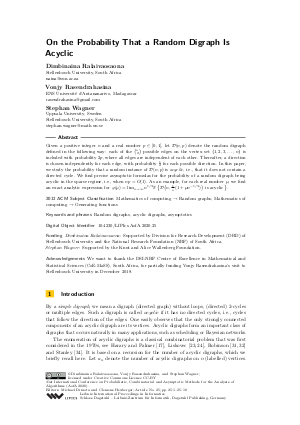@InProceedings{ralaivaosaona_et_al:LIPIcs.AofA.2020.25,
author = {Ralaivaosaona, Dimbinaina and Rasendrahasina, Vonjy and Wagner, Stephan},
title = {{On the Probability That a Random Digraph Is Acyclic}},
booktitle = {31st International Conference on Probabilistic, Combinatorial and Asymptotic Methods for the Analysis of Algorithms (AofA 2020)},
pages = {25:1--25:18},
series = {Leibniz International Proceedings in Informatics (LIPIcs)},
ISBN = {978-3-95977-147-4},
ISSN = {1868-8969},
year = {2020},
volume = {159},
editor = {Drmota, Michael and Heuberger, Clemens},
publisher = {Schloss Dagstuhl -- Leibniz-Zentrum f{\"u}r Informatik},
address = {Dagstuhl, Germany},
URL = {https://drops.dagstuhl.de/entities/document/10.4230/LIPIcs.AofA.2020.25},
URN = {urn:nbn:de:0030-drops-120557},
doi = {10.4230/LIPIcs.AofA.2020.25},
annote = {Keywords: Random digraphs, acyclic digraphs, asymptotics}
}

 Creative Commons Attribution 3.0 Unported license
Creative Commons Attribution 3.0 Unported license


































